|
|
|
Sort Order |
|
|
|
Items / Page
|
|
|
|
|
|
|
| Srl | Item |
| 1 |
ID:
101400


|
|
|
|
|
| Publication |
2011.
|
| Summary/Abstract |
Nuclear energy comes back to the discussions on the world stage as an energy source that does not contribute to global warming during production process. It can be chosen as the main source of power generation in some countries or complement the energy matrix in others. In this context, there is the need to develop new technologies for the management of radioactive waste generated by the production process. Final repositories for spent fuel are not yet in commercial operation, and techniques for fuel reprocessing have been developed, because after use, the fuel still has materials that produce energy. Some countries already use reprocessing, and develop research to make it more secure and more competitive, while others prefer to adopt policies to prevent developments in this area due to the problem of nuclear proliferation. In another line of research, new reactors are being developed in order to reduce the amount of waste in energy production and some will be designed to work in closed loop, recycling the materials generated.
|
|
|
|
|
|
|
|
|
|
|
|
|
|
|
|
| 2 |
ID:
101414


|
|
|
|
|
| Publication |
2011.
|
| Summary/Abstract |
This study examines the time series behaviour of oil production for OPEC member countries within a fractional integration modelling framework recognizing the potential for structural breaks and outliers. The analysis is undertaken using monthly data from January 1973 to October 2008 for 13 OPEC member countries. The results indicate there is mean reverting persistence in oil production with breaks identified in 10 out of the 13 countries examined. Thus, shocks affecting the structure of OPEC oil production will have persistent effects in the long run for all countries, and in some cases the effects are expected to be permanent.
|
|
|
|
|
|
|
|
|
|
|
|
|
|
|
|
| 3 |
ID:
101411


|
|
|
|
|
| Publication |
2011.
|
| Summary/Abstract |
This paper is to develop a modified Tobin's q evaluation method which successfully combines the evaluation criteria of the traditional Tobin's q and the real options. This study provides flexible thinking for decision making criteria. That is, it clearly provides decision-makers with a reference in choosing enter or exit strategies, such as quantitative indicators references. The proposed model introduces two variables stochastic process in continuous time and explores the impact of the occurrence of unexpected events on the project value, so that, it can more authentically response to the project value. The studied issue deals with the firms that have not established energy-saving equipment yet. It attempts to figure out the optimal timing to adopt an energy-saving investment project when it is beneficial and the optimal timing to terminate it when the continuous operation of that business is unprofitable. The future discounted benefit-cost ratio, Q, follows the geometric Brownian motion with the Poisson jump process and the replacement of investment equipment. Except for the evaluation of energy-saving equipment investment project, the proposed model can be applied to other related project evaluation issues, such as energy-saving, CO2 emission reduction, or general investment projects.
|
|
|
|
|
|
|
|
|
|
|
|
|
|
|
|
| 4 |
ID:
101388


|
|
|
|
|
| Publication |
2011.
|
| Summary/Abstract |
Ethanol has recently been of great interest worldwide because it is a viable economic alternative to petroleum products and it is a renewable source of energy that mitigates the emission of greenhouse gases. Brazilian bioethanol from sugarcane is the most successful case at the world level because of its low cost and low level of greenhouse gas emissions. Brazil's success with sugarcane cannot be understood as based solely on a natural comparative advantage, but as a result of efforts that culminated in a positive trajectory of technological learning, relying mostly on incremental innovations. The purpose of this article is to analyze the key aspects of the innovation system built around the Brazilian sugarcane industry. It is based on the national innovation systems approach according to which innovation results from the interaction of different institutional actors. Institutional arrangements are analyzed as the basis for the innovative process, in particular R&D and the innovation policies and strategies of the main players in the sugarcane sector, including sugar and ethanol mills, industrial goods suppliers, public and private research institutions, and governmental agencies.
|
|
|
|
|
|
|
|
|
|
|
|
|
|
|
|
| 5 |
ID:
101390


|
|
|
|
|
| Publication |
2011.
|
| Summary/Abstract |
In recent years successive Brazilian governments have actively pursued economic and social policies aimed at reducing poverty and promoting social equality and inclusion. In the field of energy, this has meant introducing and implementing programs aimed at expanding the supply of safe and reliable energy to the poorest sectors of Brazilian society, including those living in remote rural areas. This paper draws attention on the findings of extensive field research to evaluate the impact of rural electrification on energy poverty in the context of government policies aimed at promoting energy equity. The authors re-examine the concept of an energy poverty line, seeking to fine tune its application to Brazilian social and economic realities, and then apply an analytical framework (Lorenz Curve, Gap Poverty, Gap Quadratic, Gini Coefficient and Sen Index) to evaluate the effectiveness of recent efforts in Brazil to expand access to electricity. One of the main conclusions of this study is that is that rural electrification leads to a significant reduction of the energy poverty level and a consequent improvement in energy equity.
|
|
|
|
|
|
|
|
|
|
|
|
|
|
|
|
| 6 |
ID:
101404


|
|
|
|
|
| Publication |
2011.
|
| Summary/Abstract |
Many policy-makers view nuclear power as a mitigation for climate change. Efforts to mitigate and adapt to climate change, however, interact with existing and new nuclear power plants, and these installations must contend with dilemmas between adaptation and mitigation. This paper develops five criteria to assess the adaptation-mitigation dilemma on two major points: (1) the ability of nuclear power to adapt to climate change and (2) the potential for nuclear power operation to hinder climate change adaptation. Sea level rise models for nine coastal sites in the United States, a review of US Nuclear Regulatory Commission documents, and reports from France's nuclear regulatory agency provided insights into issues that have arisen from sea level rise, shoreline erosion, coastal storms, floods, and heat waves. Applying the criteria to inland and coastal nuclear power plants reveals several weaknesses. Safety stands out as the primary concern at coastal locations, while inland locations encounter greater problems with interrupted operation. Adapting nuclear power to climate change entails either increased expenses for construction and operation or incurs significant costs to the environment and public health and welfare. Mere absence of greenhouse gas emissions is not sufficient to assess nuclear power as a mitigation for climate change.
|
|
|
|
|
|
|
|
|
|
|
|
|
|
|
|
| 7 |
ID:
101398


|
|
|
|
|
| Publication |
2011.
|
| Summary/Abstract |
We examined the co-evolution of the transportation, and electricity and heat generation sectors in the Netherlands until 2040 using a MARKAL bottom-up cost optimisation model.
All scenario variants investigated indicate a switch away from crude oil-based diesel and petrol for transportation. Lowest overall CO2 abatement cost is achieved by accommodating transportation first and using relatively expensive options for emissions reduction in electricity generation if needed.
Biomass and carbon capture and storage (CCS) are used to full potential. Transportation CO2 emissions are reduced by switching to ethanol or bio-based synthetic fuels combined with CCS, and series hybrid cars if needed. Depending on the availability of biomass and carbon storage capacity, electricity is produced from biomass, coal with CCS, or wind complemented with natural gas. Indirect greenhouse gas emissions rise to 34-54% of national emissions in 2040.
The difference in annual investment required between the scenario variants with and without CO2 emissions reductions of 68% by 2040 is 4-7 billion euro/year, or 0.5-1.2% of projected GDP.
Investment costs are mostly determined by the cost of cars and electricity generation capacity. We observe competition for limited biomass supply and CO2 storage capacity between the transportation and power sectors.
|
|
|
|
|
|
|
|
|
|
|
|
|
|
|
|
| 8 |
ID:
101412


|
|
|
|
|
| Publication |
2011.
|
| Summary/Abstract |
This work compares the technical, economic and environmental (GHG emissions mitigation) performance of power generation and ethanol production from sugarcane residual biomass, considering conversion plants adjacent to a sugarcane mill in Brazil. Systems performances were simulated for a projected enzymatic saccharification co-fermentation plant (Ethanol option) and for a commercial steam-Rankine power plant (Electricity option). Surplus bagasse from the mill would be used as fuel/raw material for conversion, while cane trash collected from the field would be used as supplementary fuel at the mill. For the Electricity option, the sugarcane biorefinery (mill+adjacent plant) would produce 91 L of ethanol per tonne of cane and export 130 kWh/t of cane, while for the Ethanol option the total ethanol production would be 124 L/t of cane with an electricity surplus of 50 kWh/t cane. The return on investment (ROI) related to the biochemical conversion route was 15.9%, compared with 23.2% for the power plant, for the conditions in Brazil. Considering the GHG emissions mitigation, the environmentally preferred option is the biochemical conversion route: the net avoided emissions associated to the adjacent plants are estimated to be 493 and 781 kgCO2eq/t of dry bagasse for the Electricity and Ethanol options, respectively.
|
|
|
|
|
|
|
|
|
|
|
|
|
|
|
|
| 9 |
ID:
101401
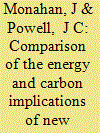

|
|
|
|
|
| Publication |
2011.
|
| Summary/Abstract |
The built environment needs to develop sustainable, decarbonised, low energy systems and approaches that are socially acceptable and economically beneficial. The UK mainstream house construction industry is being driven, through policy and regulation, towards achieving this end without evidence of how these new systems of provision are used by passively adopting households. In this paper energy use, consequential emissions of CO2, and annual running costs for a case study comprising 14 newly constructed low energy affordable homes are evaluated. Four different energy typologies are compared: ground sourced heat pumps; active solar (thermal and photovoltaic); passive solar and mechanical ventilation with heat recovery; conventional high efficiency gas boiler. The carbon embodied in construction and emitted over a 20 year occupation period for each typology is calculated. Ground source heat pumps have the highest annual primary energy demand, CO2 emission and annual running costs over the 20 year period. The homes with active solar technologies provided most benefit across all three evaluation criteria. Energy and CO2 emissions associated with end uses other than heating were similar to the UK average. This poses significant questions on the probability of policy application in the real world to deliver projected reductions in emissions of CO2.
|
|
|
|
|
|
|
|
|
|
|
|
|
|
|
|
| 10 |
ID:
101418
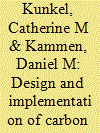

|
|
|
|
|
| Publication |
2011.
|
| Summary/Abstract |
An important concept in discussions of carbon management policies is cap and dividend, where some fraction of the revenues of an auction on emission allowances is returned to citizens on an equal per capita basis. This policy tool has some important features; it emphasizes the fact that the atmosphere is a common property resource, and it is a highly transparent measure that can be effectively used to protect the income of low-income individuals. In this paper we examine this policy in the California context, and focus on the costs and impacts of a cap and dividend scheme when applied to carbon emissions associated with electricity, natural gas and transportation services. We find that cap and dividend can effectively be used to address the economic impacts of carbon management policies, making them progressive for the lowest-income members of society. We find that the majority of households receive positive net benefits from the policy even with the government retaining half of the auction revenue. If auction revenues are instead dedicated only to low-income households, the majority of low-income households can be fully compensated even with the state government retaining upwards of 90% of auction revenues for other purposes.
|
|
|
|
|
|
|
|
|
|
|
|
|
|
|
|
| 11 |
ID:
101373
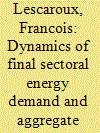

|
|
|
|
|
| Publication |
2011.
|
| Summary/Abstract |
This paper proposes a regional and sectoral model of global final energy demand. For the main end-use sectors of consumption (industrial, commercial and public services, residential and road transportation), per-capita demand is expressed as an S-shaped function of per-capita income. Other variables intervene as well, like energy prices, temperatures and technological trends. This model is applied on a panel of 101 countries and 3 aggregates (covering the whole world) and it explains fairly well past variations in sectoral, final consumption since the beginning of the 2000s. Further, the model is used to analyze the dynamics of final energy demand, by sector and in total. The main conclusion concerns the pattern of change for aggregate energy intensity. The simulations performed show that there is no a priori reason for it to exhibit a bell-shape, as reported in the literature. Depending on initial conditions, the weight of basic needs in total consumption and the availability of modern commercial energy resources, various forms might emerge.
|
|
|
|
|
|
|
|
|
|
|
|
|
|
|
|
| 12 |
ID:
101372
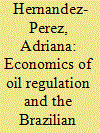

|
|
|
|
|
| Publication |
2011.
|
| Summary/Abstract |
This paper reviews the economic fundamentals for regulation in the oil industry, with a focus on the current regulatory proposal for the Brazilian oil industry. The observed exploration and production (E&P) contracts foresee much of the characteristics of the optimal contract, with a remuneration structure that combines upfront with future payments to mitigate uncertainty and incentivize exploratory efforts. In Brazil, despite slow market deconcentration since 1997's liberalization, the current oil regulation is in general consistent with an optimal regulatory response. From an economic standpoint, the 2009's new regulatory proposal prompted by the major oil discoveries offshore in Brazil reduces the power of incentive schemes with respect to exploratory and cost-reducing efforts while the changes in the net risk of the E&P offshore activities are not so clear.
|
|
|
|
|
|
|
|
|
|
|
|
|
|
|
|
| 13 |
ID:
101394


|
|
|
|
|
| Publication |
2011.
|
| Summary/Abstract |
Accelerating development in Sub-Saharan Africa will require massive expansion of access to electricity-currently reaching only about one third of households. This paper explores how essential economic development might be reconciled with the need to keep carbon emissions in check. We develop a geographically explicit framework and use spatial modeling and cost estimates from recent engineering studies to determine where stand-alone renewable energy generation is a cost effective alternative to centralized grid supply. Our results suggest that decentralized renewable energy will likely play an important role in expanding rural energy access. However, it will be the lowest cost option for a minority of households in Africa, even when likely cost reductions over the next 20 years are considered. Decentralized renewables are competitive mostly in remote and rural areas, while grid connected supply dominates denser areas where the majority of households reside. These findings underscore the need to decarbonize the fuel mix for centralized power generation as it expands in Africa.
|
|
|
|
|
|
|
|
|
|
|
|
|
|
|
|
| 14 |
ID:
101413


|
|
|
|
|
| Publication |
2011.
|
| Summary/Abstract |
Policymakers traditionally focus on regulating operational energy use in buildings, ignoring other life cycle components such as embodied energy even though this may account for a significant portion of life cycle emissions. Data relating to embodied energy and emissions in buildings is limited. However, stochastic techniques can be used to estimate the distribution of such emissions from buildings. This helps policymakers identify which instruments are appropriate for achieving emissions reductions. A primary aim of this paper is to demonstrate this approach using a sample of apartment buildings in Ireland. A Monte-Carlo simulation suggests that the average probability distribution of embodied greenhouse gases in a sample of Irish apartment buildings is characteristic of a Wakeby distribution with a long tail which can be targeted for improvement through the implementation of appropriate policies. Two policies are investigated: one regulatory whereby the embodied emissions of building materials are limited to the 80th percentile of their current distributions; and one informational where buildings are given an embodied emissions rating. It is estimated that such policies could result in an average reduction of 450 gCO2-eq/€ for the sample of apartment buildings analysed and could result in savings of €2bn to EU-27 countries in avoided carbon credits.
|
|
|
|
|
|
|
|
|
|
|
|
|
|
|
|
| 15 |
ID:
101386


|
|
|
|
|
| Publication |
2011.
|
| Summary/Abstract |
An in-depth analysis of the energy consumption and CO2 emissions of the European glass industry is presented. The analysis is based on data of the EU ETS for the period 2005-2007 (Phase I). The scope of this study comprises the European glass industry as a whole and its seven subsectors. The analysis is based on an assignment of the glass installations (ca. 450) within the EU ETS to the corresponding subsectors and an adequate matching of the respective production volumes. A result is the assessment of the overall final energy consumption (fuel, electricity) as well as the overall CO2 emissions (process, combustion and indirect emissions) of the glass industry and its subsectors in the EU25/27. Moreover, figures on fuel mix as well as fuel intensity and CO2 emissions intensity (i.e. carbon intensity) are presented for each of the subsectors on aggregated levels and for selected EU Member States separately. The average intensity of fuel consumption and direct CO2 emissions of the EU25 glass industry decreased from 2005 to 2007 by about 4% and amounted in 2007 to 7.8 GJ and 0.57 tCO2 per tonne of saleable product, respectively. The economic energy intensity was evaluated with 0.46 toe/1000€ (EU27).
|
|
|
|
|
|
|
|
|
|
|
|
|
|
|
|
| 16 |
ID:
101405


|
|
|
|
|
| Publication |
2011.
|
| Summary/Abstract |
Paleoclimate evidence and climate models indicate that certain elements of the climate system may exhibit thresholds, with small changes in greenhouse gas emissions resulting in non-linear and potentially irreversible regime shifts with serious consequences for socio-economic systems. Such thresholds or tipping points in the climate system are likely to depend on both the magnitude and rate of change of surface warming. The collapse of the Atlantic thermohaline circulation (THC) is one example of such a threshold. To evaluate mitigation policies that curb greenhouse gas emissions to levels that prevent such a climate threshold being reached, we use the MERGE model of Manne, Mendelsohn and Richels. Depending on assumptions on climate sensitivity and technological progress, our analysis shows that preserving the THC may require a fast and strong greenhouse gas emission reduction from today's level, with transition to nuclear and/or renewable energy, possibly combined with the use of carbon capture and sequestration systems.
|
|
|
|
|
|
|
|
|
|
|
|
|
|
|
|
| 17 |
ID:
101375


|
|
|
|
|
| Publication |
2011.
|
| Summary/Abstract |
Tidal energy has the technical potential to form part of a low carbon electricity sector, however, its 'social potential' is less clear, as few empirical studies of public beliefs and responses have been conducted to date. This research addressed this gap by investigating a tidal energy convertor in Northern Ireland, said to be the first grid-connected device of its kind in the world. Data was collected from 313 residents of two nearby villages using mixed methods, guided by a conceptual framework that avoided 'NIMBY' assumptions and instead drew on place theory. Findings indicated strong support for the project, arising from beliefs that the project enhanced local distinctiveness by 'putting the area on the map worldwide'; appeared visually familiar and helped tackle climate change. These positive beliefs outweighed concerns about outcome and process aspects, which were preponderant in one of the two villages. The project was interpreted to have few positive local economic outcomes, to potentially threaten local livelihoods and local ecology. Moreover, residents expressed cynicism about consultation procedures, and reported low levels of behavioural engagement. Implications of the findings for the literature on public acceptance of renewable energy, and for the emerging marine energy sector specifically, are discussed.
|
|
|
|
|
|
|
|
|
|
|
|
|
|
|
|
| 18 |
ID:
101420


|
|
|
|
|
| Publication |
2011.
|
| Summary/Abstract |
This communication reviews the oil and natural gas resources, reserves and proved reserves of the European Union (EU) and the European Economic Area (EEA). Experts may apply different methodologies and classifications to assess hydrocarbon deposits, which makes their coherent and sound evaluation a challenging task. The analysis presented in this paper shows that there is variation in reported estimates for the EU and EEA oil and gas proved reserves, which is however relatively small; and EEA holds very small and continuously declining shares of world oil and gas proved reserves, about 1.3% and 2.9%, respectively. Nevertheless, conventional reserves and resources and more importantly unconventional gas resources offer a significant potential to increase the European proved reserves. This however requires the proper mapping and assessment of these sources and a rigorous research and development programme for the exploitation of this untapped potential, which could play a significant role in the security of the European energy supply in the years to come.
|
|
|
|
|
|
|
|
|
|
|
|
|
|
|
|
| 19 |
ID:
101403
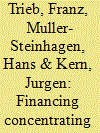

|
|
|
|
|
| Publication |
2011.
|
| Summary/Abstract |
The paper presents a strategy for the market introduction of concentrating solar power (CSP) plants in the Middle East and North Africa (MENA) that will not require considerable subsidization and will not constitute a significant burden for electricity consumers in the region. In the first section, the paper explains the need of MENA countries for sustainable supply of electricity and calculates the cost of electricity for a model case country. In the second part, the cost development of concentrating solar power plants is calculated on the basis of expectations for the expansion of CSP on a global level. After that, the challenges for the market introduction of CSP in MENA are explained. Finally, we present a strategy for the market introduction of CSP in MENA, removing the main barriers for financing and starting market introduction in the peak load and the medium load segment of power supply. The paper explains why long-term power purchase agreements (PPA) for CSP should be calculated on the basis of avoided costs, starting in the peak load segment. Such PPA are not yet available, the paper aims to convince policy makers to introduce them.
|
|
|
|
|
|
|
|
|
|
|
|
|
|
|
|
| 20 |
ID:
101406


|
|
|
|
|
| Publication |
2011.
|
| Summary/Abstract |
Development and diffusion of new renewable energy technologies play a central role in mitigating climate change. In this context, small-scale deep geothermal power has seen growing interest in recent years as an environmentally friendly, non-intermittent energy source with large technical potential. Following the first successful demonstration projects, the German geothermal industry is currently experiencing an internationally unparalleled growth. In this study we explore the factors driving this development, and the role geothermal power production could play in the future of the German electricity market. For this, we apply the scenario technique, based on literature analysis and interviews with companies operating actively in the field. Our findings highlight the importance of political support and framework conditions in the electricity market, with the best prospects in a decentralised energy system based on renewable energy sources, where high investment costs and the risk of discovery failure are balanced by the benefits of low-carbon base load power.
|
|
|
|
|
|
|
|
|
|
|
|
|
|
|
|
|
|
|
|
|